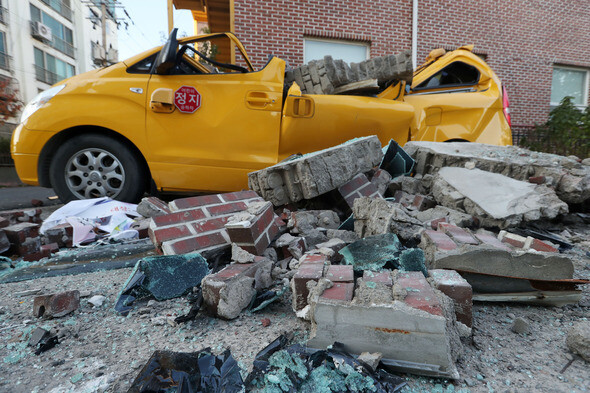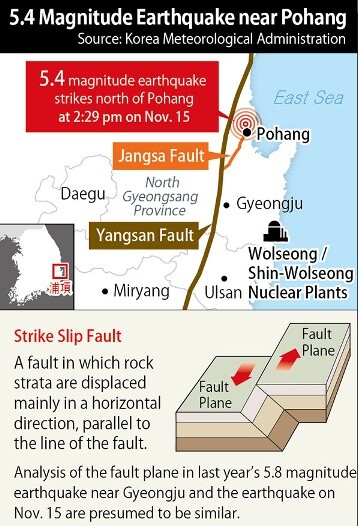hankyoreh
Links to other country sites 다른 나라 사이트 링크
Pohang rocked by second most powerful earthquake in Korean history

A little over a year after the Gyeongju earthquake, South Korea is being swept once again by the fear of earthquakes. The tremors were felt around the country, including Seoul. With the two most powerful earthquakes in Korean history occurring in the space of a year in the southeastern region – which contains the world’s highest concentration of nuclear reactors – concerns are increasing about the series of earthquakes. There is also growing interest in how the repeated earthquakes in the region will impact the government’s future policy for nuclear power.
“An earthquake measuring 5.4 in magnitude occurred at an area 9km north of Buk District, Pohang, North Gyeongsang Province, at 2:29:31 this afternoon,” the Korea Meteorological Administration (KMA) announced on Nov. 15. This was the second most powerful earthquake in Korean history, following the 5.8-magnitude earthquake that struck Gyeongju on Sept. 12, 2016. There were two foreshocks, with a magnitude of 2.2 and 2.6, that occurred in the same region before the earthquake. After the main shock, 26 aftershocks with at least a magnitude of 2.0 (the most powerful measured 4.3) had occurred as of 8:20 pm. The KMA urged residents to be cautious, since the aftershocks could continue.
The Pohang earthquake occurred at the southeastern fault zone, an area where stress has built up for a long time, and geologists are considering the possibility that this earthquake was triggered by a combination of the Great East Japan Earthquake in 2011 and by the Gyeongju earthquake last year, which was affected by the previous earthquake. This earthquake could affect neighboring fault lines, triggering yet another quake.
In the aftermath of the earthquake, South Korea’s College Scholastic Ability Test (CSAT), which had been scheduled for Nov. 16, was delayed one week, to Nov. 23. “After inspecting all 14 of the test sites around Pohang, we found cracks in a large number of the test buildings, including Daedong High School. To ensure the safety of those sitting for the test and the fairness of the CSAT, we have decided to delay it until Nov. 23, one week from now,” said Deputy Prime Minister for Social Affairs and Education Minister Kim Sang-gon in an emergency press conference held at 8:20 pm.
The earthquake caused a great commotion as shocked residents of Pohang and other cities rushed out of buildings. While the magnitude of this earthquake was lower than the one that struck Gyeongju last year, it occurred at a more shallow level, 9km below the surface of the earth, making the tremors very perceptible. Roads in some parts of Pohang cracked in two, while the walls of buildings collapsed, crushing parked cars.

“Office equipment and books tumbled to the floor. I heard car tires being punctured. There was a series of bangs,” said Kim Sang-jo, 59, who was at an office just over 10km from the epicenter of the Pohang earthquake. According to South Korea’s National Fire Agency, 10 people sustained light injuries and 63 people were rescued around the country following the earthquake. As of 5 pm, 7,810 calls reporting the earthquake from around the country had been placed to 119, South Korea’s emergency number.
“Nothing unusual has occurred at any of the surrounding nuclear reactors, including the Wolseong reactors, which are 45km away, and all of the reactors are operating normally,” said Korea Hydro and Nuclear Power (KHNP). “However, the earthquake detection system was activated at Wolseong reactor 1, so we are currently inspecting the equipment,” the agency added.
Immediately after returning to South Korea from his trip to southeast Asia the same afternoon, President Moon Jae-in presided over an emergency meeting of his senior secretaries and aides at the Blue House to deal with the Pohang earthquake. During the meeting, Moon instructed them to “thoroughly assess the safety not only of the nuclear reactors but also of various industrial facilities.” At 2:44 pm, 15 minutes after the earthquake occurred, the Blue House’s National Crisis Management Center used a satellite phone to report the earthquake to the South Korean Presidential Plane, with Moon aboard, and Moon was briefed on the developments by his personal secretary four minutes later.
By Kim Jeong-su, Cho Kye-wan, Kim Mi-hyang, and Seong Yeon-cheol, staff reporters
Please direct questions or comments to [english@hani.co.kr]

Editorial・opinion
![[Column] Park Geun-hye déjà vu in Yoon Suk-yeol [Column] Park Geun-hye déjà vu in Yoon Suk-yeol](https://flexible.img.hani.co.kr/flexible/normal/500/300/imgdb/original/2024/0424/651713945113788.jpg) [Column] Park Geun-hye déjà vu in Yoon Suk-yeol
[Column] Park Geun-hye déjà vu in Yoon Suk-yeol![[Editorial] New weight of N. Korea’s nuclear threats makes dialogue all the more urgent [Editorial] New weight of N. Korea’s nuclear threats makes dialogue all the more urgent](https://flexible.img.hani.co.kr/flexible/normal/500/300/imgdb/original/2024/0424/7317139454662664.jpg) [Editorial] New weight of N. Korea’s nuclear threats makes dialogue all the more urgent
[Editorial] New weight of N. Korea’s nuclear threats makes dialogue all the more urgent- [Guest essay] The real reason Korea’s new right wants to dub Rhee a founding father
- [Column] ‘Choson’: Is it time we start referring to N. Korea in its own terms?
- [Editorial] Japan’s rewriting of history with Korea has gone too far
- [Column] The president’s questionable capacity for dialogue
- [Column] Are chaebol firms just pizza pies for families to divvy up as they please?
- [Column] Has Korea, too, crossed the Rubicon on China?
- [Correspondent’s column] In Japan’s alliance with US, echoes of its past alliances with UK
- [Editorial] Does Yoon think the Korean public is wrong?
Most viewed articles
- 1[Column] Park Geun-hye déjà vu in Yoon Suk-yeol
- 2Will NewJeans end up collateral damage in internal feud at K-pop juggernaut Hybe?
- 3N. Korean hackers breached 10 defense contractors in South for months, police say
- 4[Editorial] New weight of N. Korea’s nuclear threats makes dialogue all the more urgent
- 5[Cine feature] A new shift in the Korean film investment and distribution market
- 6Up-and-coming Indonesian group StarBe spills what it learned during K-pop training in Seoul
- 7[Column] The clock is ticking for Korea’s first lady
- 8Terry Anderson, AP reporter who informed world of massacre in Gwangju, dies at 76
- 9Thursday to mark start of resignations by senior doctors amid standoff with government
- 10Kim Jong-un expressed ‘satisfaction’ with nuclear counterstrike drill directed at South